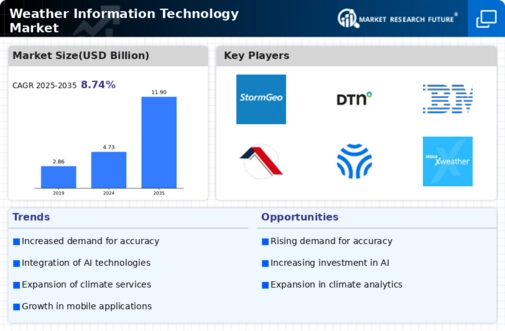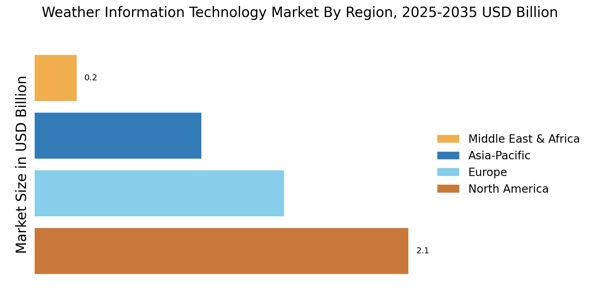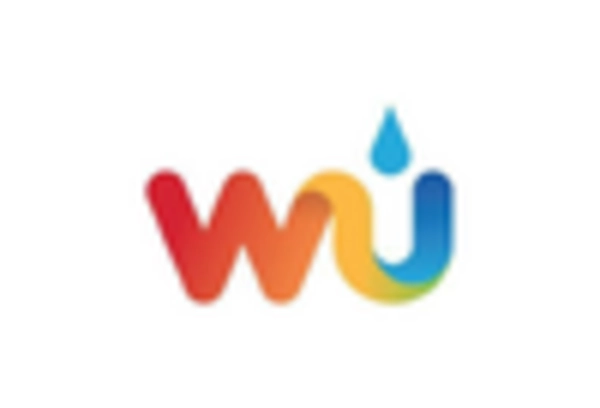Integration of IoT in Weather Monitoring
The Weather Information Technology Market is increasingly integrating Internet of Things (IoT) technologies into weather monitoring systems. IoT devices, such as smart sensors and connected weather stations, facilitate real-time data collection and analysis, enhancing the accuracy of weather predictions. This integration allows for more localized and precise weather information, which is particularly beneficial for sectors like agriculture and urban planning. As the adoption of IoT solutions continues to rise, the market is expected to expand, with forecasts indicating a potential increase in market size by over 15% in the next five years. This trend underscores the transformative impact of IoT on weather information technology.
Advancements in Remote Sensing Technologies
The Weather Information Technology Market is witnessing substantial advancements in remote sensing technologies, which enhance the accuracy and timeliness of weather data collection. Innovations such as satellite imagery and radar systems provide real-time insights into atmospheric conditions, enabling better forecasting and analysis. The integration of these technologies into weather information systems has led to improved predictive capabilities, which are essential for disaster management and climate monitoring. As organizations increasingly adopt these advanced tools, the market is expected to expand, with investments in remote sensing technologies projected to reach several billion dollars by 2026. This growth reflects the critical role of technology in enhancing weather information services.
Growing Awareness of Climate Change Impacts
The Weather Information Technology Market is significantly influenced by the increasing awareness of climate change and its impacts on various sectors. As extreme weather events become more frequent, businesses and governments are prioritizing climate resilience strategies, which necessitate accurate weather data. This heightened awareness drives demand for sophisticated weather information systems that can provide insights into climate patterns and potential risks. Consequently, the market is likely to see a surge in investments aimed at developing innovative solutions for climate adaptation and mitigation. Analysts project that the market could witness a growth rate of approximately 10% annually as stakeholders seek to enhance their preparedness for climate-related challenges.
Rising Investment in Weather Technology Startups
The Weather Information Technology Market is experiencing a surge in investment directed towards weather technology startups. Venture capitalists and private equity firms are increasingly recognizing the potential of innovative weather solutions that leverage artificial intelligence and big data analytics. This influx of capital is fostering the development of cutting-edge technologies that enhance forecasting accuracy and provide actionable insights for various industries. As a result, the market is likely to see a proliferation of new products and services aimed at addressing the diverse needs of consumers and businesses alike. Analysts suggest that this trend could lead to a market expansion of approximately 12% annually, reflecting the growing interest in weather technology innovations.
Increased Demand for Accurate Weather Forecasting
The Weather Information Technology Market experiences heightened demand for precise weather forecasting due to the growing reliance on accurate data for various sectors. Industries such as agriculture, transportation, and energy are increasingly dependent on reliable weather information to optimize operations and mitigate risks. For instance, the agricultural sector utilizes advanced forecasting tools to enhance crop yield and manage resources effectively. As a result, the market for weather information technology is projected to grow significantly, with estimates suggesting a compound annual growth rate of over 8% in the coming years. This trend indicates a robust market environment where technological advancements play a crucial role in meeting the evolving needs of diverse industries.


















Leave a Comment